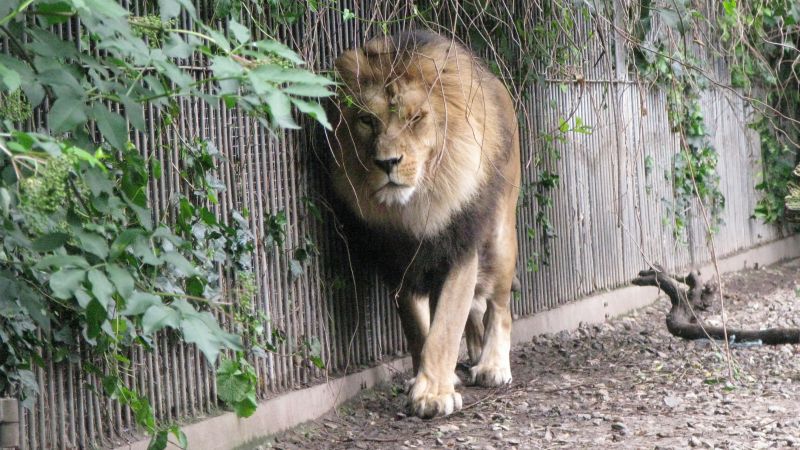Science
Denmark Zoo Seeks Donations of Unwanted Pets for Predators

A zoo in northern Denmark is inviting pet owners to donate unwanted animals such as guinea pigs, rabbits, chickens, and even small horses. The Aalborg Zoo aims to use these donations to feed its carnivorous predators, rather than display them. In a recent Facebook post, the zoo emphasized its goal to “imitate the natural food chain” for the animals in its care.
The post featured an image of a lynx, showcasing the type of predator that will benefit from this initiative. According to the zoo, “Chickens, rabbits, and guinea pigs form an important part of the diet of our predators.” By accepting these animals, Aalborg Zoo believes it can ensure that nothing goes to waste, while also promoting natural behavior, nutrition, and well-being among its predators.
Ethical Considerations and Practices
On its official website, the zoo provided further details about the process. Donated animals will be “gently euthanized” by trained staff before being served as food. This practice aligns with the zoo’s commitment to providing a diet that closely resembles what these animals would consume in the wild. The zoo houses several carnivorous species, including the Asiatic lion, European lynx, and Sumatran tiger.
The public request for donations has sparked a lively debate online. Some individuals are protesting the idea of turning pets into prey, while others commend the zoo’s efforts to maintain natural feeding behaviors. Deputy director of Aalborg Zoo, Pia Nielsen, stated in comments shared by The Guardian that this initiative has been longstanding and is a common practice in Denmark.
“For many years at Aalborg Zoo, we have fed our carnivores with smaller livestock,” Nielsen explained. “When keeping carnivores, it is necessary to provide them with meat—preferably with fur, bones, etc.—to give them as natural a diet as possible.” She further noted, “Therefore, it makes sense to allow animals that need to be euthanized for various reasons to be of use in this way.”
Historical Context and Public Reactions
Nielsen emphasized that many guests and partners of the zoo appreciate the opportunity to contribute. The types of livestock received as donations typically include chickens, rabbits, guinea pigs, and horses. This initiative follows a history of controversy surrounding animal management practices in Danish zoos.
In 2014, the Copenhagen Zoo euthanized a healthy young giraffe named Marius to prevent inbreeding, despite public outcry and a petition against the action. Marius’s carcass was used for research and to feed carnivorous animals at the zoo, including lions, tigers, and leopards. Shortly thereafter, the zoo faced public criticism again when it euthanized four lions to make room for a new male in hopes of breeding a new generation of cubs.
The ongoing discussions surrounding these practices reveal the complexities of animal husbandry in zoos. While some advocate for natural feeding methods, others question the ethics of using domesticated pets as food for captive predators. As the debate continues, Aalborg Zoo remains focused on its mission to provide a naturalistic environment for its inhabitants.
CNN has reached out to Aalborg Zoo for additional comments on this initiative.
-

 Lifestyle3 months ago
Lifestyle3 months agoLibraries Challenge Rising E-Book Costs Amid Growing Demand
-

 Sports3 months ago
Sports3 months agoTyreek Hill Responds to Tua Tagovailoa’s Comments on Team Dynamics
-

 Sports3 months ago
Sports3 months agoLiverpool Secures Agreement to Sign Young Striker Will Wright
-

 Lifestyle3 months ago
Lifestyle3 months agoSave Your Split Tomatoes: Expert Tips for Gardeners
-

 Lifestyle3 months ago
Lifestyle3 months agoPrincess Beatrice’s Daughter Athena Joins Siblings at London Parade
-

 World3 months ago
World3 months agoWinter Storms Lash New South Wales with Snow, Flood Risks
-

 Science3 months ago
Science3 months agoTrump Administration Moves to Repeal Key Climate Regulation
-

 Science2 months ago
Science2 months agoSan Francisco Hosts Unique Contest to Identify “Performative Males”
-

 Business3 months ago
Business3 months agoSoFi Technologies Shares Slip 2% Following Insider Stock Sale
-

 Science3 months ago
Science3 months agoNew Tool Reveals Link Between Horse Coat Condition and Parasites
-

 Sports3 months ago
Sports3 months agoElon Musk Sculpture Travels From Utah to Yosemite National Park
-

 Science3 months ago
Science3 months agoNew Study Confirms Humans Transported Stonehenge Bluestones









